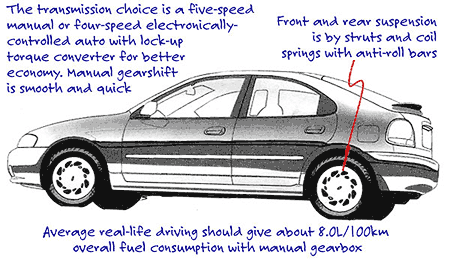BY MALCOLM LIVERMORE | 7th May 2003

Introduced in 1981, it was actually a Mazda 323 but personalising by Ford stylists and engineers gave it a distinct character of its own.
The Laser has gradually grown in size - the KJ model released in 1994 is not much smaller than its former big brother of a few years earlier, the Telstar - and its place in the small car segment was taken by the Festiva.
Laser sits in the small to medium segment of the market with plenty of rivals from Japan, South Korea and Europe.
The Liata is an upgraded version of the Laser hatch, available in LXi and Ghia models. The Ghia features different styling, a long list of extra equipment and a higher price tag.
The LXi comes with two engine choices - 1.6 or 1.8-litre - but otherwise the equipment level of the two models is similar. We will be looking at the 1.6-litre version.
The Mazda-designed 1598cc, twin overhead cam engine is a quiet, smooth and well proven unit with excellent performance.
It is mounted transversely in the chassis and drives the front wheels through either a four-speed automatic transmission or five-speed manual gearbox.
Suspension both front and rear is by coil springs and MacPherson struts, with anti-roll bars.
Steering is power-assisted rack and pinion with a quick three turns lock to lock.
Brakes are discs all round, power-assisted, and wheel/tyre size is a generous 185/65 R14.
The KJ Liata continued the success of Ford stylists in setting the car apart from its blood brother, the Mazda 323. The rounded shape is pleasing and modern without departing too far from the conventional.
The interior of the Liata is among the roomiest in the class with seating for four in comfort and five at a pinch. But the centre of the rear seat sits proud, making the third passenger feel less at home.
Entry to the rear seat is a little difficult for taller people due to the down sweep of the rear door opening.
The front seats are comfortable and the driver's seat is adjustable for tilt and height.
Instrumentation consists of speedo, tachometer and fuel and temperature gauges housed in a curved binnacle.
The glovebox is spacious and there are useful bins and boxes for bits and pieces. Airbags for driver and front passenger are an option.
Luggage space is good due to the hatchback design with fold-down rear seat backs increasing the available space if needed.
On the road, the Liata performs well, the willing 1.6-litre engine spinning freely and quietly with a nice sporty feel.
The handling is a little soft with some understeer and body roll when pushed hard into corners but the ride is good and the manual gearshift light and positive to operate.
The brakes are very effective under all normal driving conditions.
Fuel economy should be about 8.0L/100km around town, increasing to 6.5L/100km on the highway.
The Laser design and production techniques are well proven and service problems are few and far between. The Ford dealer network provides excellent service backup and spare parts prices are about average for imported Japanese models.
The Laser Liata is a leading contender in a hotly contested segment of the market. It has good performance and fuel economy, a pleasing appearance, comfortable interior and good finish.
With reliable service backup and a long history of success in the market place, it is an excellent choice as a small to medium- sized family car.